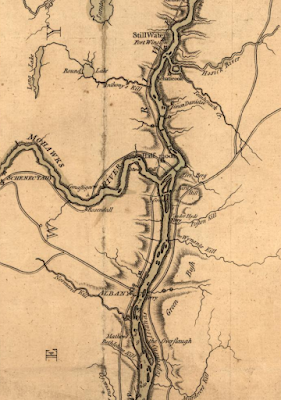The German Route - "We Marched To Neustadt"
On the morning of October 20th, 1777, Lieutenant-General John Burgoyne's defeated British and German troops parted ways. For the next two weeks they would march separately, before reuniting to travel on a common route through central Massachusetts to confinement in Charlestown. Some had served together for over a year. Major-General Friedrich Adolf Riedesel for example, had arrived in Canada in June of 1776, to lead the German troops who would accompany Burgoyne on his expedition from Canada.
The Germans first full day's march, starting in Schaghticoke, New York, took them south to a stopping point just opposite the mouth of the Mohawk River. Brunswick Grenadier Johann Bense noted of the day simply: "marched to New City near Fort Halfmoon." [1] Massachusetts Militia Private Joshua Pillsbury, of one those guarding the German column, recorded little more, other than it was a Monday and they marched twelve miles. [2]Burgoyne's Germans were correct in saying the town was recently settled, but had backwards with regard to its name. While commonly referred to as "New City" early on, it had been settled as Lansingburg, and would come to be known by that name. At the time of the American Revolution the town was so new it often did not appear on period maps, including a map of the Hudson River Valley published by William Fadden in London in 1777, an excerpt of which is pictured above, from a copy in the collection of the Library of Congress.
The location, layout and even the naming of Lansingburgh was planned from its beginning. The History of Lansingburgh N.Y. From The Year 1670 To 1877, published in 1877, tells the story of its early history. Its origin in 1771 is traced back to Abraham Jacob Lansing, who had a part of his farm surveyed and streets laid out to create a home for settlers coming from New England after the end of the French and Indian War. Its location on the east side of the Hudson River, ten miles north of Albany, was expected to accommodate "[t]he associated interests of Dutch farmers and the New England merchants..." Unfortunately for those who settled there, the low level of the river in the summer limited shipping to "vessels only of the smallest capacity", until years later when a dam was built to raise water levels in the summer months. [5]
Lansingburgh 's history and identity have been preserved by its Historical Society, even though its separate identity would end in 1900 when it became a part of Troy, New York. The Society's web presence includes a number of maps of the area, as well as the story of its settlement and evolution. Interesting for our purposes, is a post re-printing a June 8, 1914, letter to the editor of the Troy Times regarding a brick home at First and 114 Street, where according to local tradition "... General Burgoyne rested on his way down [to Albany] after his defeat."
Lieutenant Samuel Armstrong, of the Eight Massachusetts Regiment of the Continental Line, had taken temporary leave of the Northern Army due to illness, and come to New City four days ahead of the German column. Arriving on the 16th, he noted it was difficult to find a house to stay in, and that he spent all day on the 17th searching for lodging. Armstrong's diary suggests Burgoyne didn't stop in Lansingburg, as he noted on October 18th"... Genl. Burgoine passed down toward Albany as a prisoner under the care of our Light Horse, upon the Western Side of the River..." and "five Genls came to New City." Sick, Armstrong remained until November 1st, noting on October 20th: "This Evening the Brunswick Prisoners came to New City on their Way to Boston..." [6]
The Germans were impressed by what they saw on the way to Lansingburg on their first full day's march, through what was then a farming community. Traveling after the harvest, Riedesel's troop observed "... incredible stores of all sorts of grains. Great heaps of it lay in bays covered by temporary roofs." Less welcome, and a sign of things to come, was a change in the weather. As noted by one officer of their stop on October 20th, "The corps had to bivouac and endure snow and rain that night." [7]
Finding signs of the passing of the Convention Army through Lansingburg is a challenge. The town grew as a port in the nineteenth century, developed and became part of Troy, New York, and then faded as industry and jobs moved elsewhere. Few sites and buildings remain which may have been there in 1777. One that does, the "Old House", is said to date from 1720, but is a private residence. The Lansingburgh Village Burying Ground on the northeast corner of Third and 107th Streets, dates from before the Revolution, the first burial there said to date from 1771.




Comments
Post a Comment